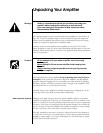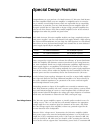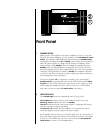
13
test of the Nº333 at maximum power requires about 45 amperes at 120V. (The
laws of physics refuse to be cheated. Long-term, you cannot deliver more power
into the speaker than you can pull from the wall.)
Thirty-two TO-3 output transistors are distributed in the heatsinks of the Nº 333
to conduct and control the flow of its remarkable power capabilities to the loud-
speaker. There are eight matched, complementary pairs of output transistors in
each channel of the amplifier. Similarly, the Nº332 uses 24 TO-3 output transistors
in six matched, complementary pairs of output transistors for each channel, and
the Nº331 uses 16 TO-3 output transistors in four matched, complementary pairs
of output transistors for each channel.
No known high quality loudspeaker can absorb the continuous full power capa-
bility of the Nº 333. (Nor would you want to be present in the room were you to
find one that could do so.) However, many high quality loudspeakers may require
rather extreme power levels on a short term basis when reproducing music at
realistic levels. The 300-series amplifiers can answer these needs with impunity,
without any power supply “sag” and without altering their sonic performance in
any way. The resultant imperturbable nature of these amplifiers is reflected in the
authority and control with which they reproduce music. Your selection of any
particular model depends only on the maximum power you need, based on your
loudspeakers, listening room, and listening habits.
Adaptive Biasing of
the Output Stage
Magazines and product literature have both contributed to a great deal of poorly-
informed discussion of “class A” operation over the years. Unfortunately, the ther-
mal management problems of true class A operation in a high-current output
stage are severe, and introduce serious sonic compromises of their own. For this
reason, the output stage of your new amplifier are not class-A biased in a tradi-
tional fashion. (All voltage gain stages of the 300-series amplifiers are biased to
operate in a full class A mode in order to keep the active devices safely within
their most linear, distortion-free range at all times.)
The 300-series amplifiers use a proprietary adaptive biasing scheme developed
by Madrigal (and first introduced in the Nº 33 Reference Monaural Amplifiers)
that delivers the sonic advantages of a Class A output stage without incurring the
substantial inefficiencies and consequent thermal problems of pure Class A op-
eration. Uniquely, this adaptive biasing scheme never allows the output devices
themselves to be reverse-biased. This approach results in greatly reduced dy-
namic distortions, and a sweeter sound that exhibits a greater sense of ease at all
volume levels.
Extensive Protection Your 300-series power amplifier will shut itself down if it senses any of a num-
ber of fault conditions which could cause damage to either itself or to your loud-
speakers. These fault conditions include:
• the presence of DC (direct current) at the output
• either over-voltage or under-voltage conditions on the AC mains (±10%)
• unsafe operating temperatures in any of several critical areas
within the amplifier
If any of these fault conditions is sensed while the amplifier is in either standby
or fully on, the amplifier will shut down completely (off mode, not merely
standby). Moreover, it will not turn on again until the fault condition is corrected.


















